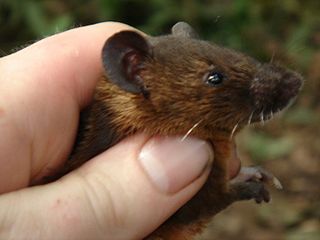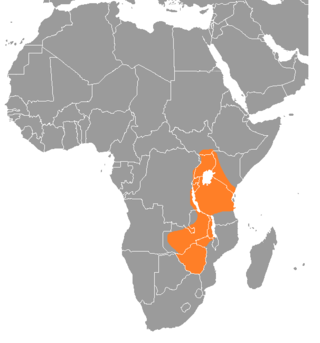
The African golden cat is a wild cat endemic to the rainforests of West and Central Africa. It is threatened due to deforestation and bushmeat hunting and listed as Vulnerable on the IUCN Red List. It is a close relative of both the caracal and the serval. Previously, it was placed in the genus Profelis. Its body size ranges from 61 to 101 cm with a 16 to 46 cm long tail.

The African brush-tailed porcupine is a species of rat-like Old World porcupine, indigenous to a broad belt of Africa ranging from Guinea on the west coast to Kenya on the east. This is a common species with a very wide range, and despite it being used extensively for bushmeat, the International Union for Conservation of Nature has rated its conservation status as being of "least concern".

The long-tailed spiny rat is a spiny rat species found in Bolivia, Brazil and Paraguay.

Euryoryzomys nitidus, also known as the elegant oryzomys or elegant rice rat, is a rodent species in the family Cricetidae. Previously it was known as Oryzomys nitidus, but it is not closely related to Oryzomys as that genus is now constructed. Its range includes Bolivia, Brazil and Peru to the east of the Andes, in lowland tropical rainforest as well as forest in the eastern foothills of the mountains, at elevations from 50 to 2,000 m.
The West African shaggy rat is a species of rodent in the family Muridae. It is found in Benin, Cameroon, Ivory Coast, Gambia, Ghana, Guinea, Guinea-Bissau, Liberia, Mali, Nigeria, Senegal, Sierra Leone, and Togo. Its natural habitats are subtropical or tropical seasonally wet or flooded lowland grassland and swamps. It is a common species and the International Union for Conservation of Nature has rated its conservation status as being of "least concern".

The marmoset rat, also known as the greater marmoset rat, is a species of rodent in the family Muridae. It is found in Malaysia, Myanmar, and Thailand. Its natural habitat is subtropical or tropical dry forests. It is threatened by habitat loss.
The montane hylomyscus or montane wood mouse is a species of rodent in the family Muridae. A long-coated species with brownish-grey upper parts and whitish-grey underparts, it occurs in the uplands of tropical Central Africa where its natural habitat is tropical moist montane forests.
The Mount Oku hylomyscus is a species of rodent in the family Muridae. Found only on Mount Oku, Cameroon, in tropical Central Africa, its natural habitat is tropical moist montane forests. It has a very small range and is threatened by habitat destruction, so the International Union for Conservation of Nature has rated its conservation status as being "critically endangered".
The Mount Oku rat is a species of rodent in the family Muridae. It is the only species in the genus Lamottemys. It is found only in Cameroon where its natural habitat is subtropical or tropical moist montane forests. It is threatened by habitat destruction.
The Ethiopian forest brush-furred rat or golden-footed brush-furred rat, is a species of rodent in the family Muridae. It is endemic to Ethiopia where its natural habitat is subtropical or tropical moist montane forests. It is threatened by habitat loss.

The rusty-bellied brush-furred rat is a species of rodent in the family Muridae. It is found in Angola, Benin, Cameroon, Central African Republic, Republic of the Congo, Democratic Republic of the Congo, Ivory Coast, Equatorial Guinea, Gabon, Ghana, Guinea, Kenya, Liberia, Nigeria, Sierra Leone, Tanzania, Togo, and Uganda. Its natural habitats are subtropical or tropical moist lowland forests, subtropical or tropical seasonally wet or flooded lowland grassland, arable land, and pastureland.
Peters's mouse is a species of rodent in the family Muridae. It is found in Benin, Cameroon, Central African Republic, Republic of the Congo, Democratic Republic of the Congo, Ivory Coast, Equatorial Guinea, Ethiopia, Gabon, Ghana, Guinea, Kenya, Liberia, Nigeria, Sierra Leone, Togo, and Uganda. Its natural habitats are subtropical or tropical dry forests and dry savanna.
The African groove-toothed rat or mill rat is a species of rodent in the family Muridae found in Angola, Cameroon, the Central African Republic, the Republic of the Congo, the Democratic Republic of the Congo, Ivory Coast, Ghana, Guinea, Kenya, Liberia, Malawi, Rwanda, Tanzania, and Uganda. Its natural habitats are subtropical or tropical moist lowland forest and subtropical or tropical seasonally wet or flooded lowland grassland. It is threatened by habitat loss.

Hildegarde's broad-headed mouse or Hildegarde's zelotomys is a species of rodent in the family Muridae. It is found in Central Africa.

The dwarf scaly-tailed squirrel is a species of rodent in the family Anomaluridae. It is found in Cameroon, Central African Republic, Republic of the Congo, Democratic Republic of the Congo, Equatorial Guinea, Gabon and Uganda. The species is nocturnal and arboreal and lives in subtropical or tropical lowland rainforest. Membranes attached to its limbs and tail enable it to glide between trees. This squirrel is currently not considered to be threatened by habitat destruction; "much of the habitat within parts of the known range of this species is relatively intact, and the species is unlikely to be experiencing any significant declines."
Kellen's dormouse is a species of rodent in the family Gliridae. It is native to tropical Africa where its range extends from the Gambia and Senegal to Kenya and Tanzania. Its natural habitats are subtropical or tropical dry forests, and moist or dry savannah.

The red-legged sun squirrel is a species of rodent in the family Sciuridae, also commonly known as the isabelline red-legged sun squirrel. It is native to tropical western and central Africa where its range extends from Senegal in the west, through Nigeria and the Republic of Congo to Uganda and Tanzania in the east. Its natural habitats are subtropical or tropical moist lowland forests and moist savanna. This species is thought to be common and has a very wide distribution, so the International Union for Conservation of Nature has rated its conservation status as being of "least concern".

The forest giant squirrel or Stanger's squirrel is a species of rodent in the family Sciuridae found in Angola, Benin, Burundi, Cameroon, the Central African Republic, the Republic of the Congo, the Democratic Republic of the Congo, Ivory Coast, Equatorial Guinea, Gabon, Ghana, Kenya, Liberia, Nigeria, Rwanda, Sierra Leone, Tanzania, Togo, and Uganda. Its natural habitats are subtropical or tropical moist lowland forests and plantations.

The lesser cane rat is a species of rodent in the family Thryonomyidae. It is found in Cameroon, Chad, Democratic Republic of the Congo, Ethiopia, Kenya, Malawi, South Sudan, Tanzania, Uganda, Zambia, Zimbabwe, and possibly Mozambique. Its natural habitats are subtropical or tropical dry shrubland, subtropical or tropical dry lowland grassland, and shrub-dominated wetlands.
The eastern rainforest grammomys, also known as the eastern rainforest thicket rat, is a species of rodent from the family Muridae.











